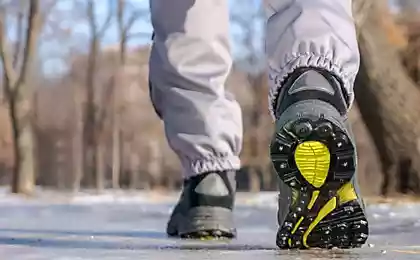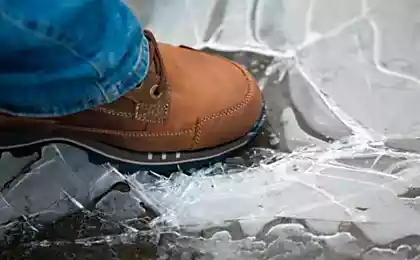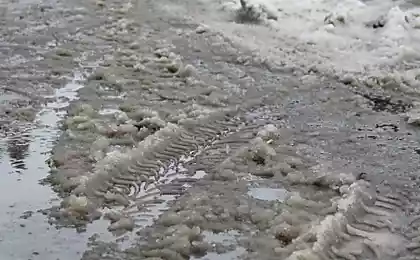144
Rub the soles of winter shoes with this tool to no longer slide into ice
In recent years, winter is not so much a refreshing frost and fluffy snow, as it upsets with eternal slush against the background of small night frosts. Until the morning, sub-zero air temperature manages to turn wet sidewalks into a rain-polished rink. In order not to feel on the ice known clumsy cloth-hoofed, I have long abandoned high-heeled boots. Getting to work in the morning is easier. But, after one day unsuccessfully "landed" on the arm, it came to me: the problem with slippery soles remained. Therefore, I had to study the question of what can be applied to shoes from ice to confidently stand on their feet.

It turned out that shoes from ice apply special substances, glue, pull or attach different materials and devices, and also treat the sole with improvised tools. Consider the most popular methods.
What to put on shoes from ice? To avoid falls, a special spray is sprayed on the surface of the sole. Apply this substance should be on a dry and clean base the day before a walk.

To prevent excessive sliding of the legs, shoes should be put on special spring or rubber studded linings and icebreakers. These devices are desirable to buy in advance. They are sold online and in hardware stores.
In a hopeless situation, you can stretch ordinary socks over your shoes. Caprons will work, too, but they break faster. It doesn’t look good, but you have to accept it if you don’t want to get hurt.

What is put on the sole so that it does not slip? In an emergency, you can paste several strips of tissue adhesive tape on your shoes. To securely attach, the surface of the sole must be clean and dry.
There are already ready-made stickers from Naledi on sale. All you have to do is stick them on a cleaned platform.
With the use of superglue on the tankettes, you can attach flexible rigid parts of an ordinary kitchen sponge. These scrapers will not allow the feet to move in different directions.
On the sole can be glued with water-resistant glue pieces of sandpaper.
Feel flaps attached to the sweeps will ensure reliable movement along the icy path.
Calmly walk on the ice will help trim rubber, glued to a solid sole.

To protect yourself during walking, it is recommended to glue sand, metal shavings or crushed wire on the bottom of the sole. To do this, shoes should be well washed and dried. Before applying glue, the sole must be degreased. Then on its wide part and flat heel apply a thin layer of glue and sprinkle everything with cooked crumb or sand. After the adhesive is dried, the excess abrasive must be shaken off. As long as the coating is rough, the shoes will not slide. If necessary, the procedure can be repeated.

What to do with the sole so that the ground does not go under your feet? Erased sweeps should be treated with sandpaper or file. Thus, the shoes will appear previously disappeared tread, which will prevent riding on the ice path.

What did you put on your boots with ice? In the recent past, special metal horseshoes and tiles were nailed to boots. They began to twitch unpleasantly, but stopped to slide. Instead of tiles could use small carnations and screws. It should be noted that this method could only be used on thick sweeps or heels.
If you are afraid of ruining expensive shoes, do not risk or experiment. Take your favorite couple to the master. The shoemaker will restore the erased tread, apply additional spraying on the smooth sole or advise other options. Either way, you'll be happy.

It turned out that shoes from ice apply special substances, glue, pull or attach different materials and devices, and also treat the sole with improvised tools. Consider the most popular methods.
What to put on shoes from ice? To avoid falls, a special spray is sprayed on the surface of the sole. Apply this substance should be on a dry and clean base the day before a walk.

To prevent excessive sliding of the legs, shoes should be put on special spring or rubber studded linings and icebreakers. These devices are desirable to buy in advance. They are sold online and in hardware stores.
In a hopeless situation, you can stretch ordinary socks over your shoes. Caprons will work, too, but they break faster. It doesn’t look good, but you have to accept it if you don’t want to get hurt.

What is put on the sole so that it does not slip? In an emergency, you can paste several strips of tissue adhesive tape on your shoes. To securely attach, the surface of the sole must be clean and dry.
There are already ready-made stickers from Naledi on sale. All you have to do is stick them on a cleaned platform.
With the use of superglue on the tankettes, you can attach flexible rigid parts of an ordinary kitchen sponge. These scrapers will not allow the feet to move in different directions.
On the sole can be glued with water-resistant glue pieces of sandpaper.
Feel flaps attached to the sweeps will ensure reliable movement along the icy path.
Calmly walk on the ice will help trim rubber, glued to a solid sole.

To protect yourself during walking, it is recommended to glue sand, metal shavings or crushed wire on the bottom of the sole. To do this, shoes should be well washed and dried. Before applying glue, the sole must be degreased. Then on its wide part and flat heel apply a thin layer of glue and sprinkle everything with cooked crumb or sand. After the adhesive is dried, the excess abrasive must be shaken off. As long as the coating is rough, the shoes will not slide. If necessary, the procedure can be repeated.

What to do with the sole so that the ground does not go under your feet? Erased sweeps should be treated with sandpaper or file. Thus, the shoes will appear previously disappeared tread, which will prevent riding on the ice path.

What did you put on your boots with ice? In the recent past, special metal horseshoes and tiles were nailed to boots. They began to twitch unpleasantly, but stopped to slide. Instead of tiles could use small carnations and screws. It should be noted that this method could only be used on thick sweeps or heels.
If you are afraid of ruining expensive shoes, do not risk or experiment. Take your favorite couple to the master. The shoemaker will restore the erased tread, apply additional spraying on the smooth sole or advise other options. Either way, you'll be happy.
Modern children do not like winter, but Soviet babies could hardly be driven off the street.
Tamara Globa's first forecast this year, preparing for change in January























